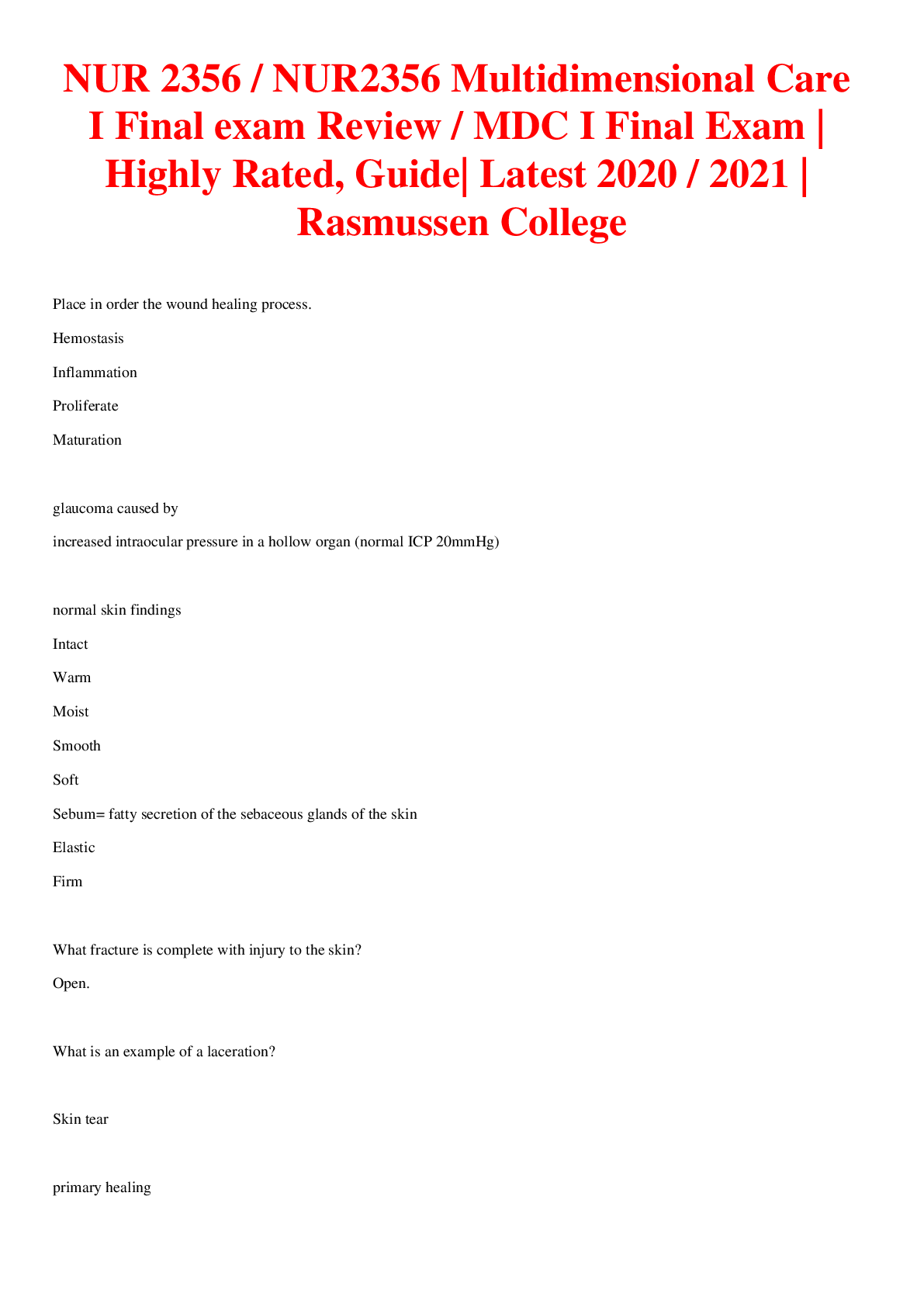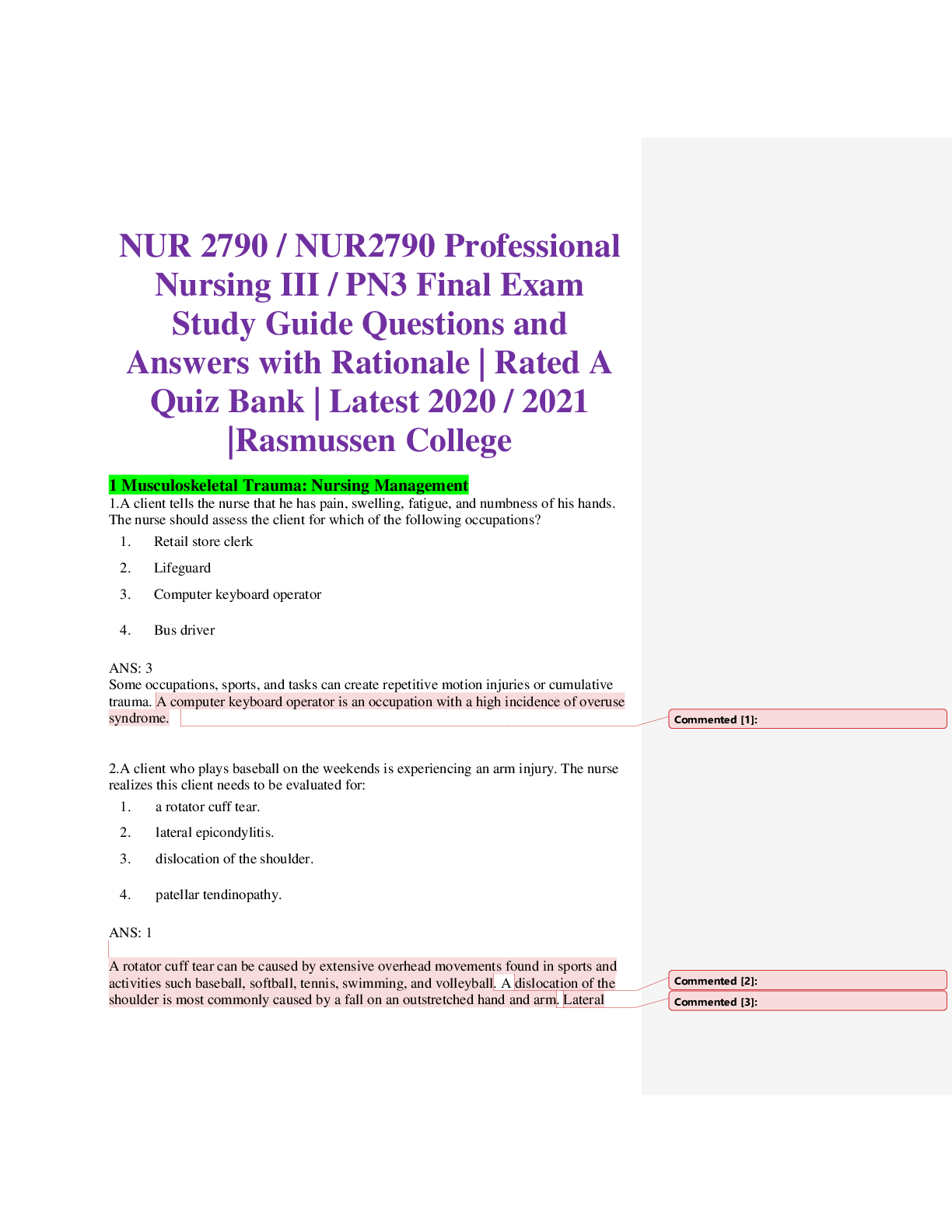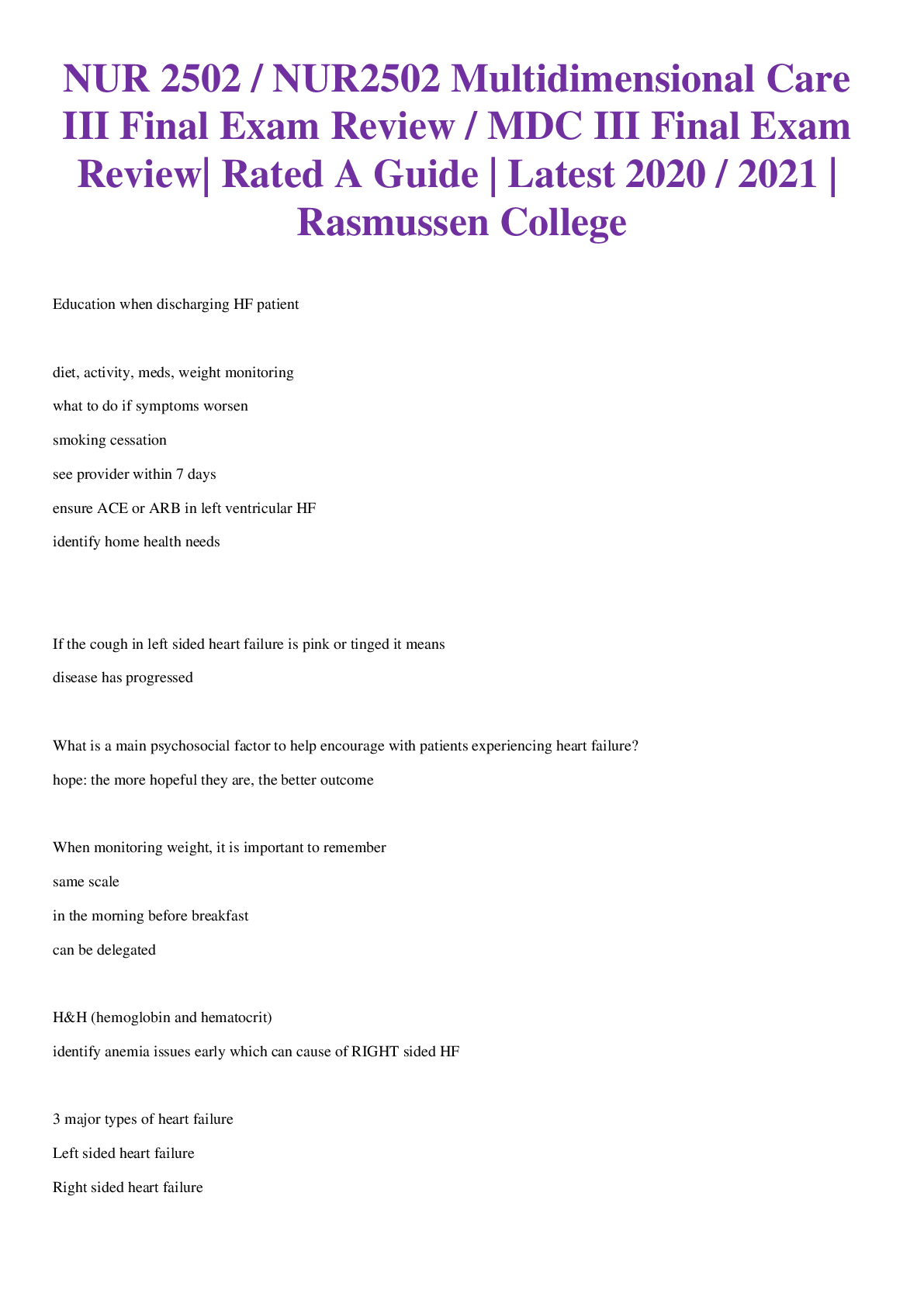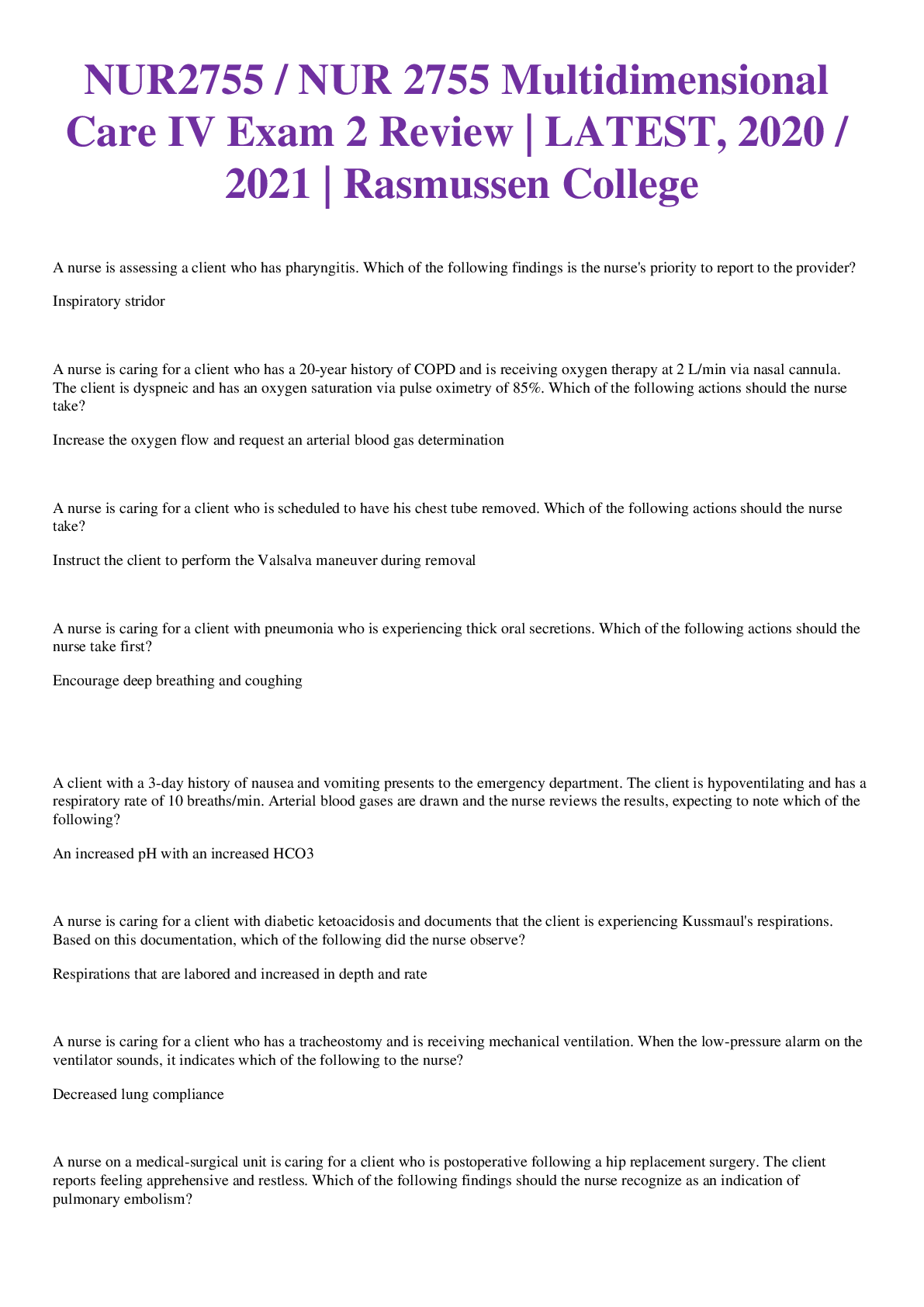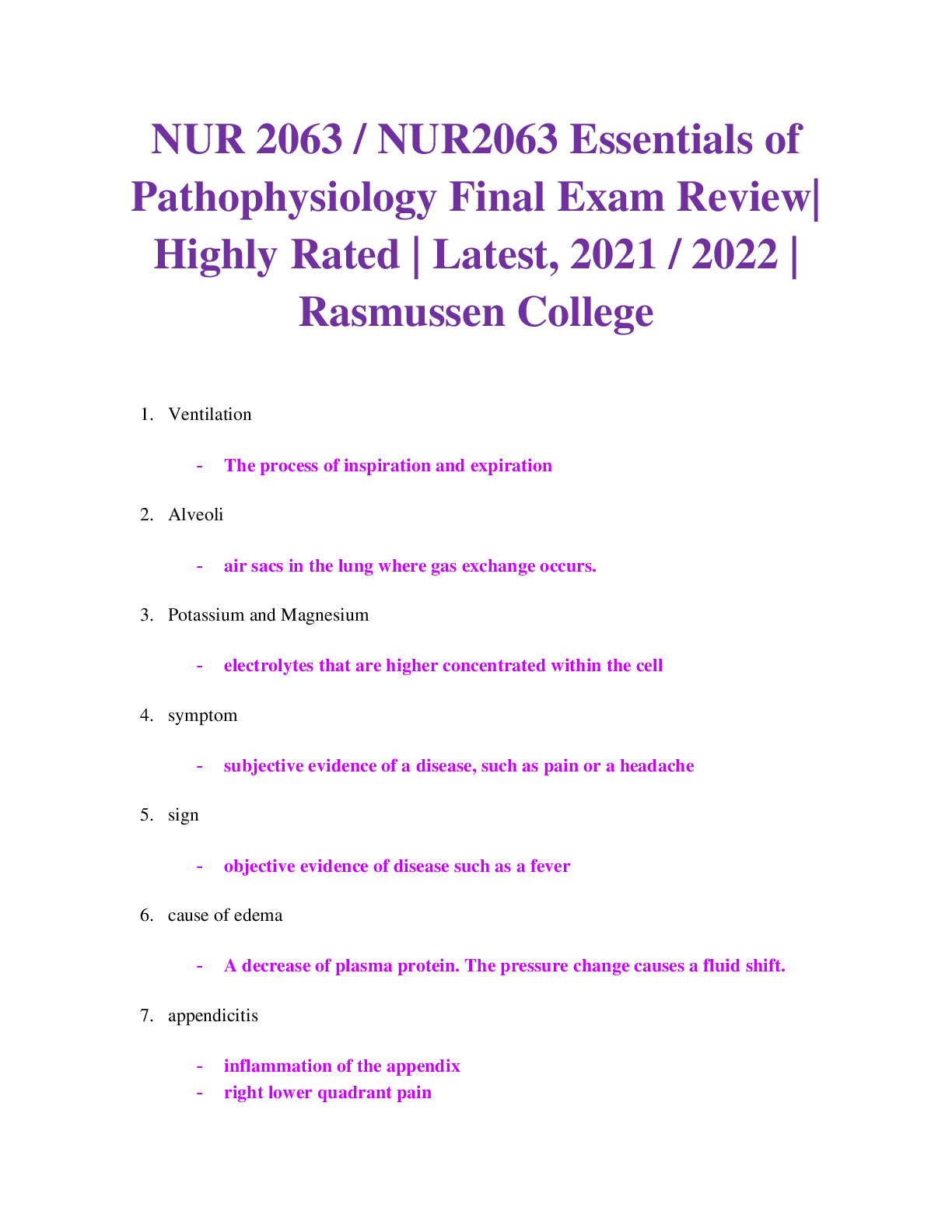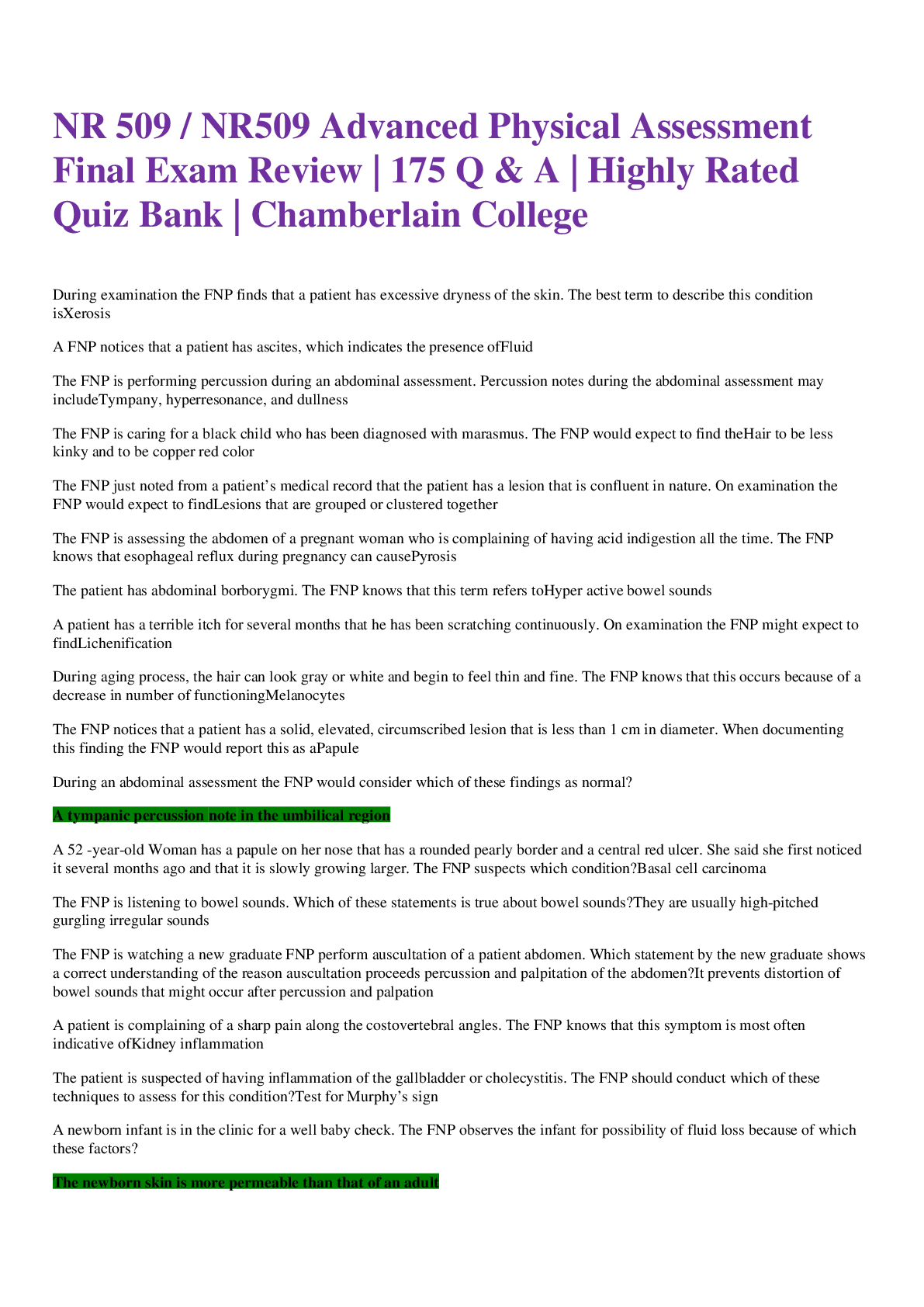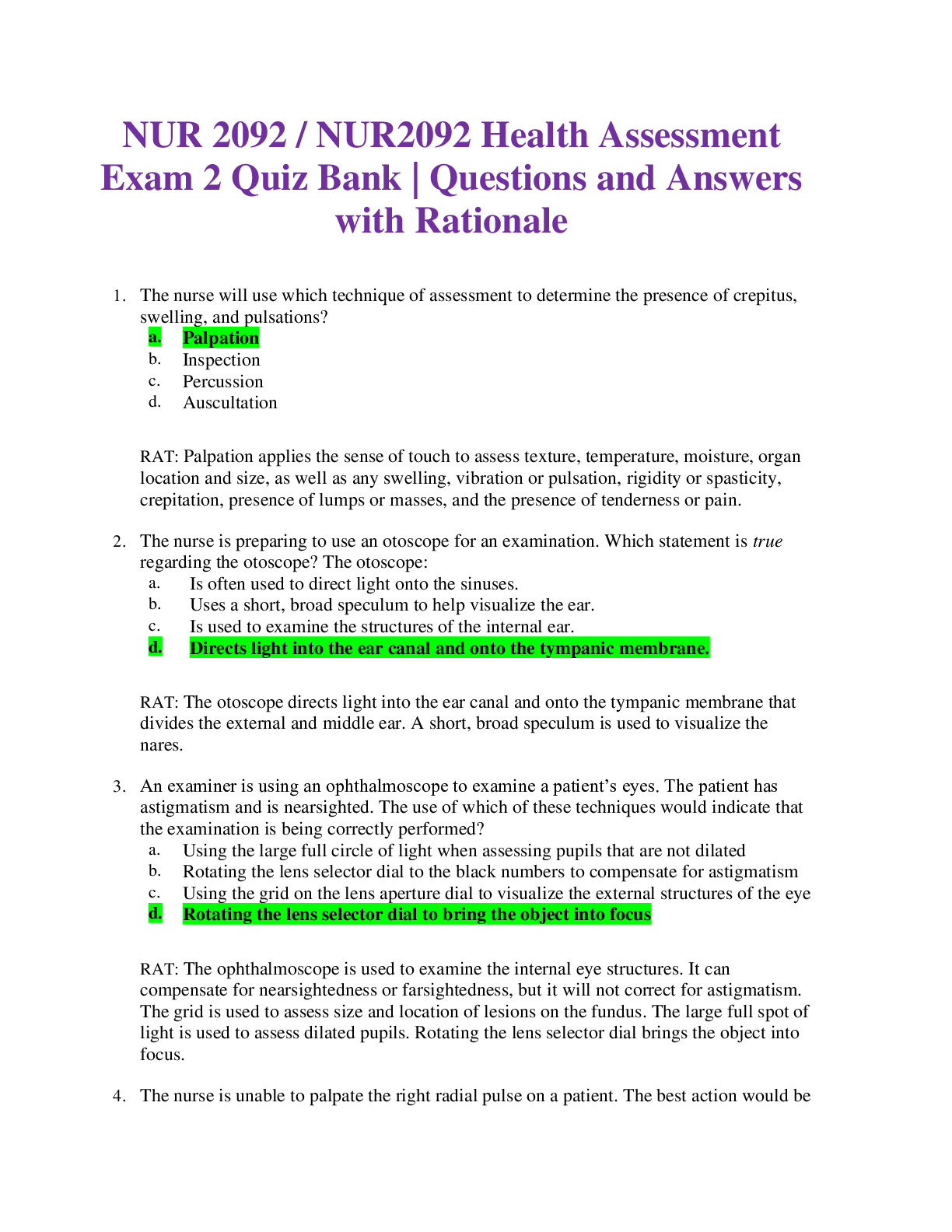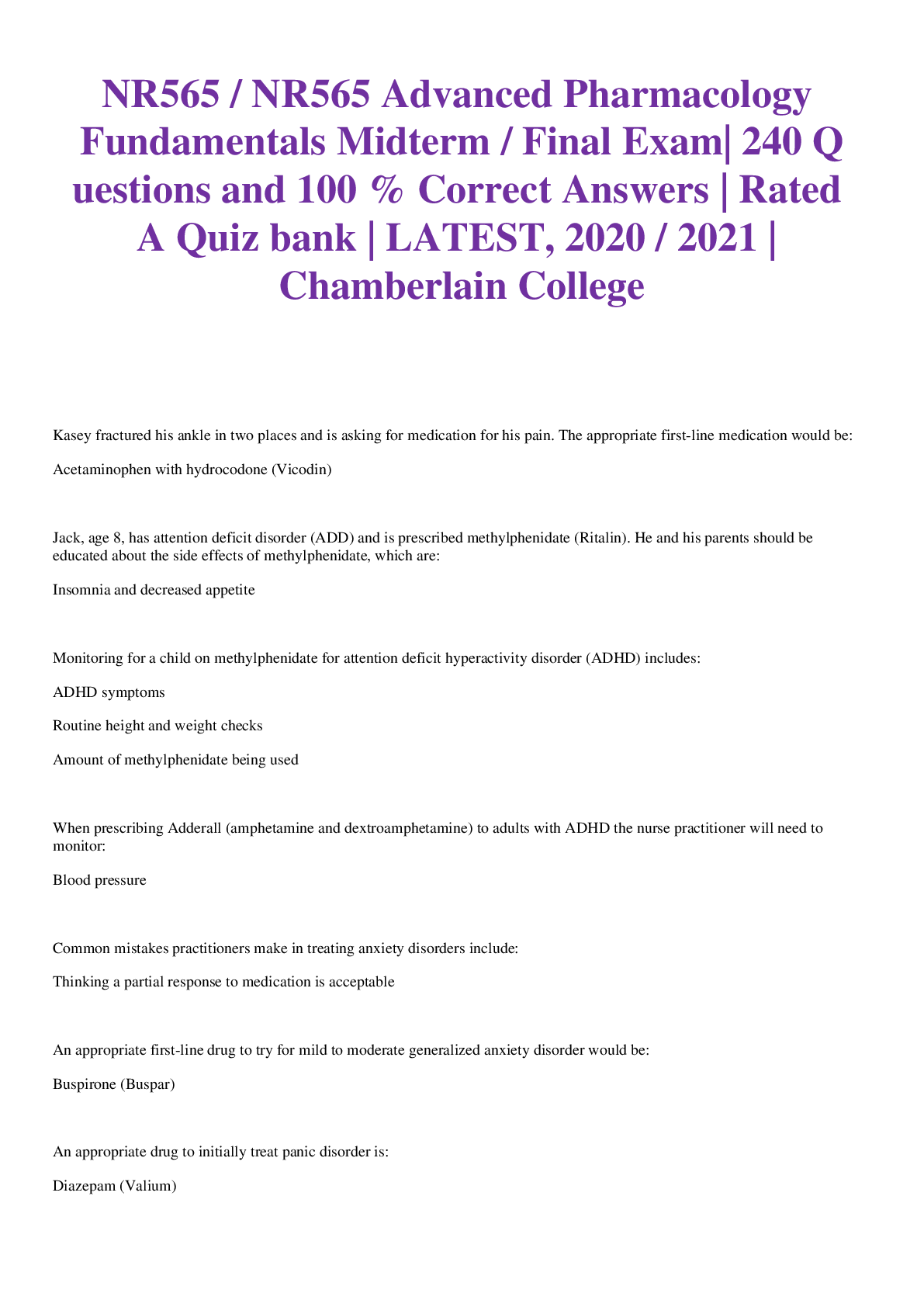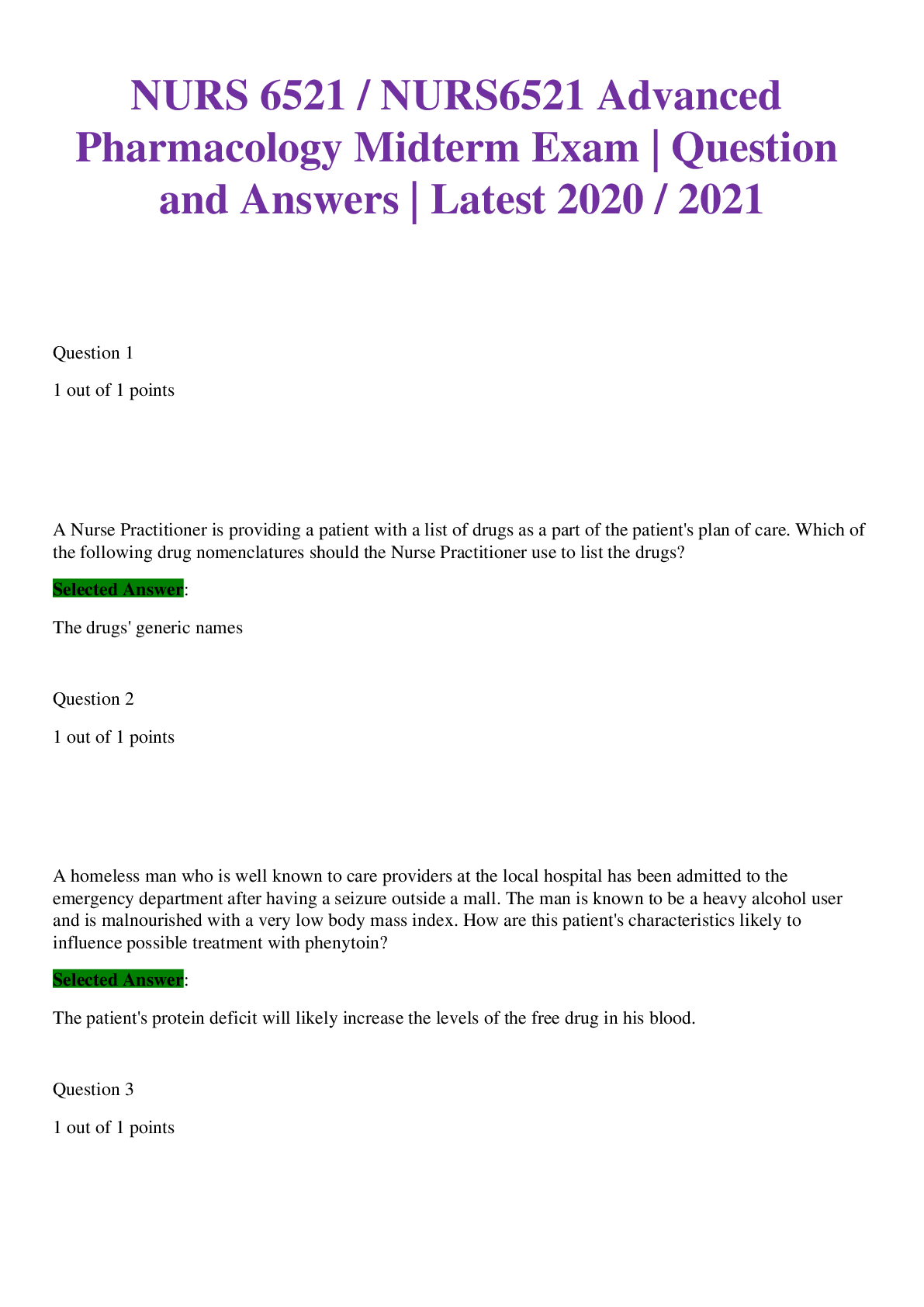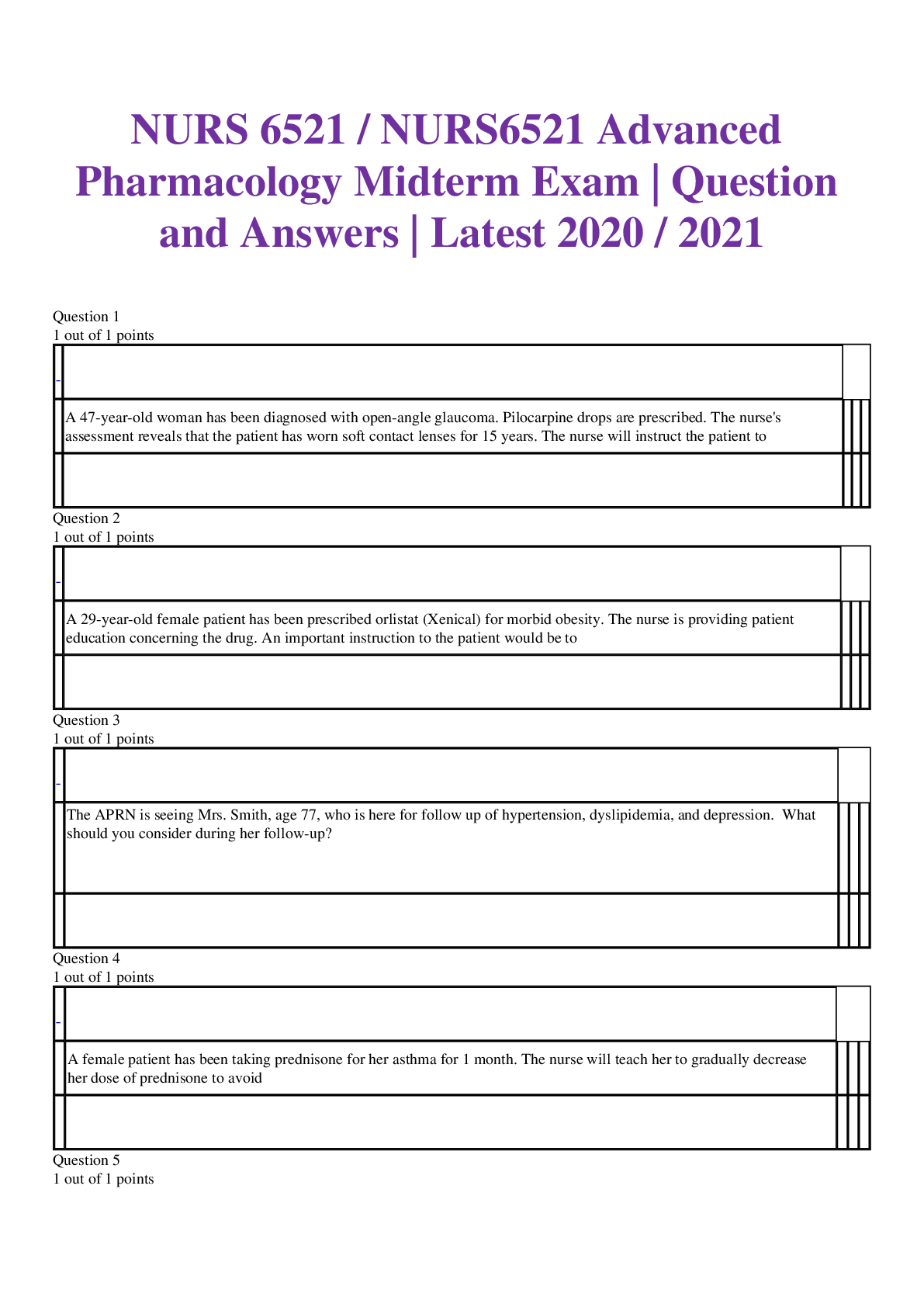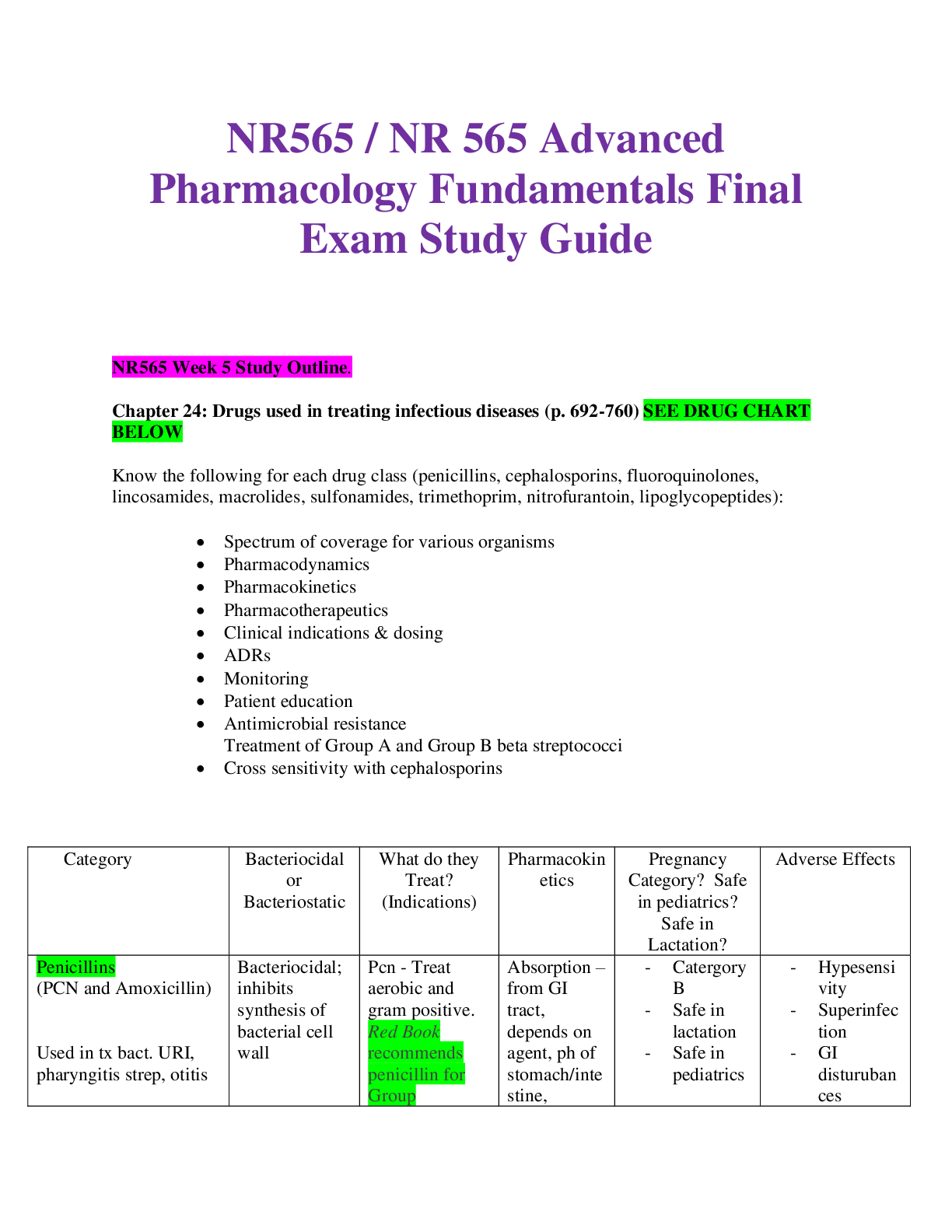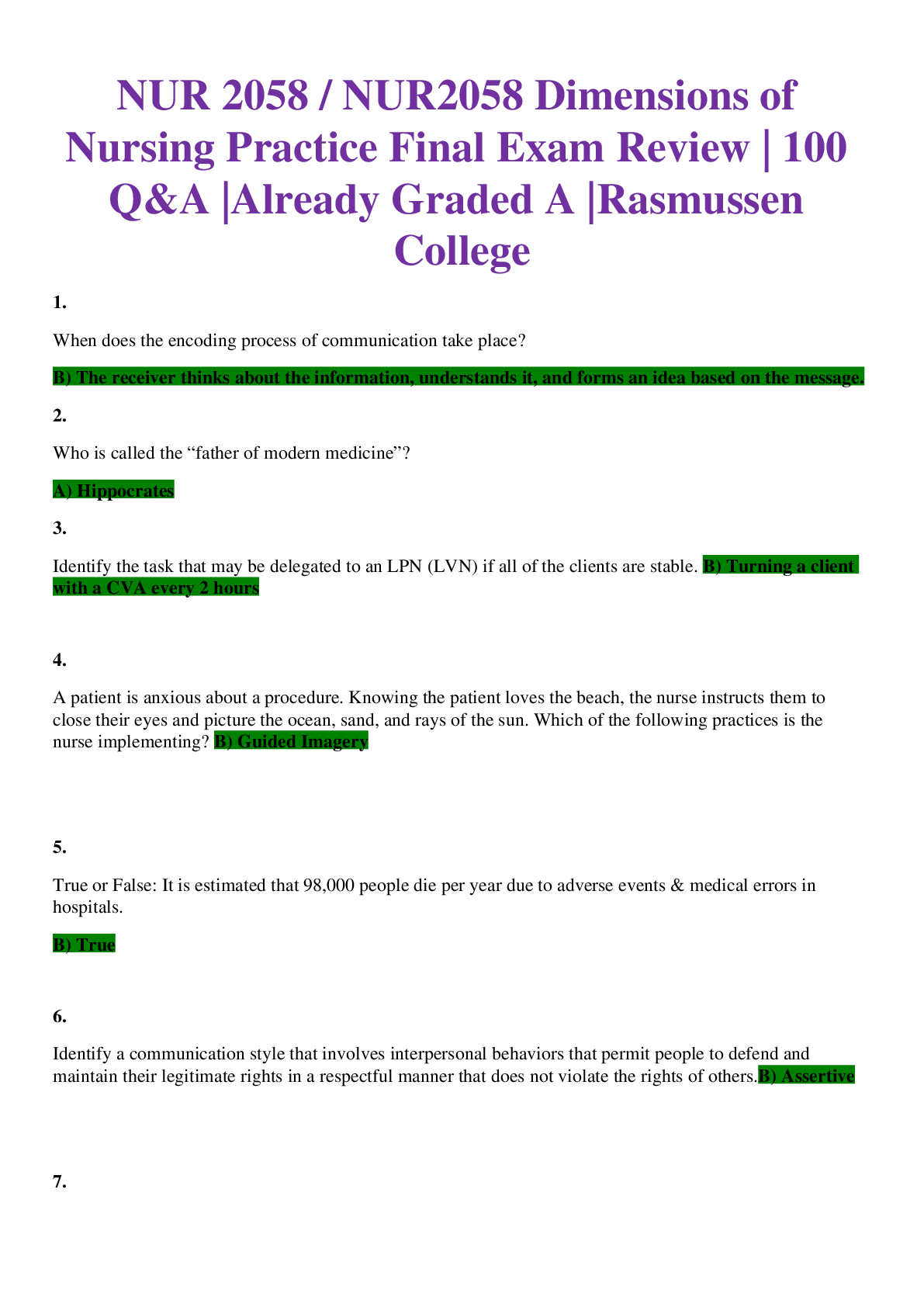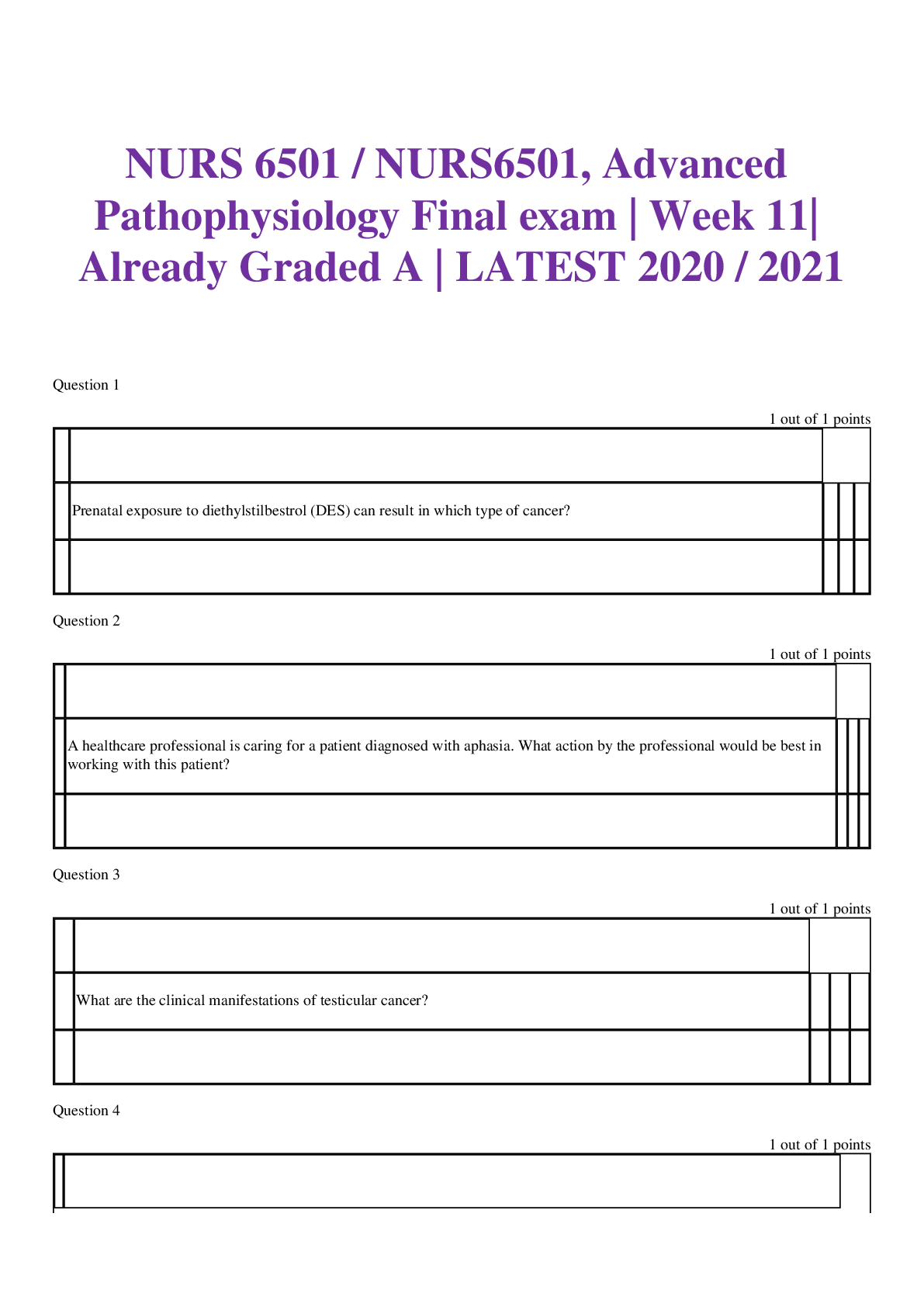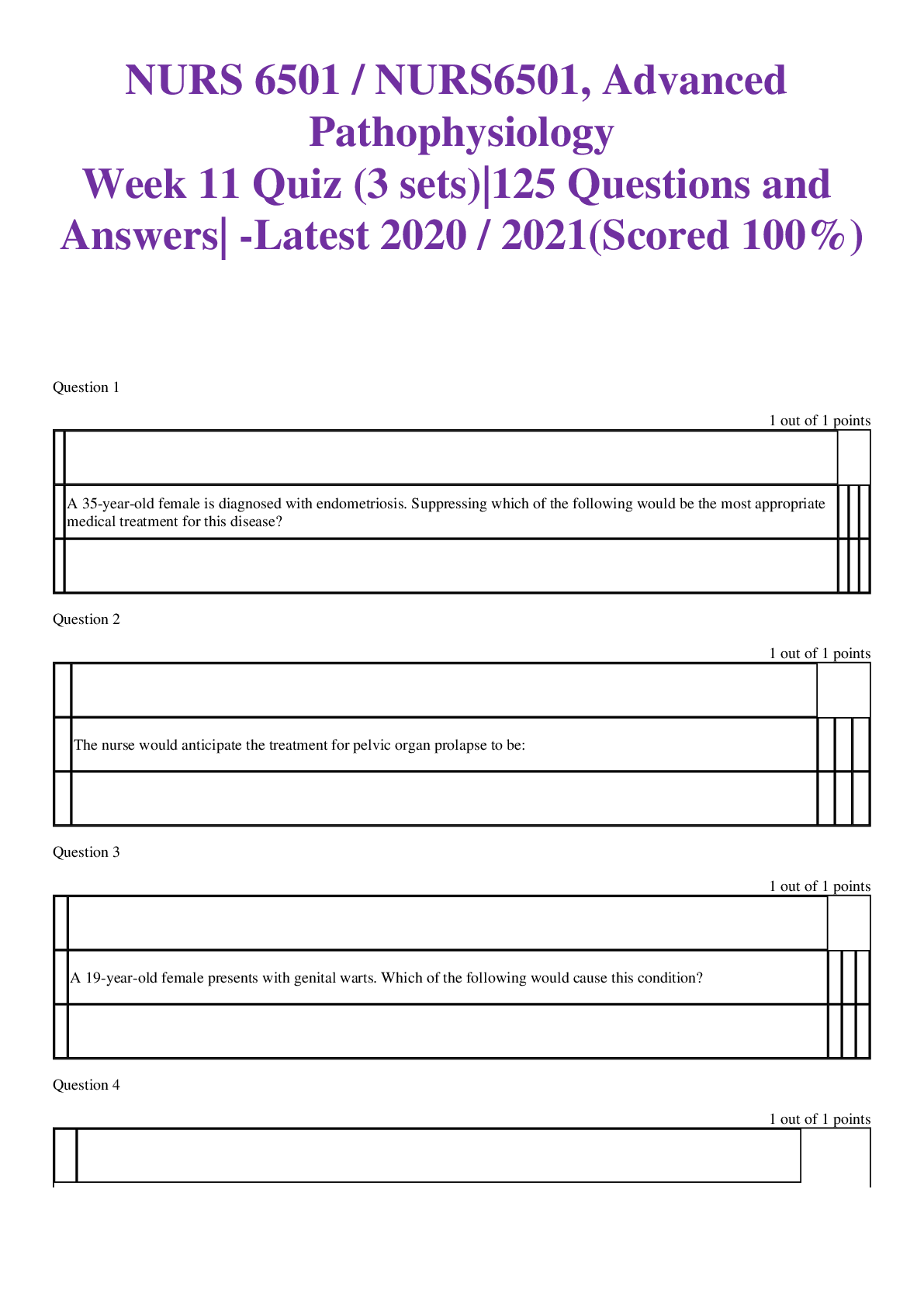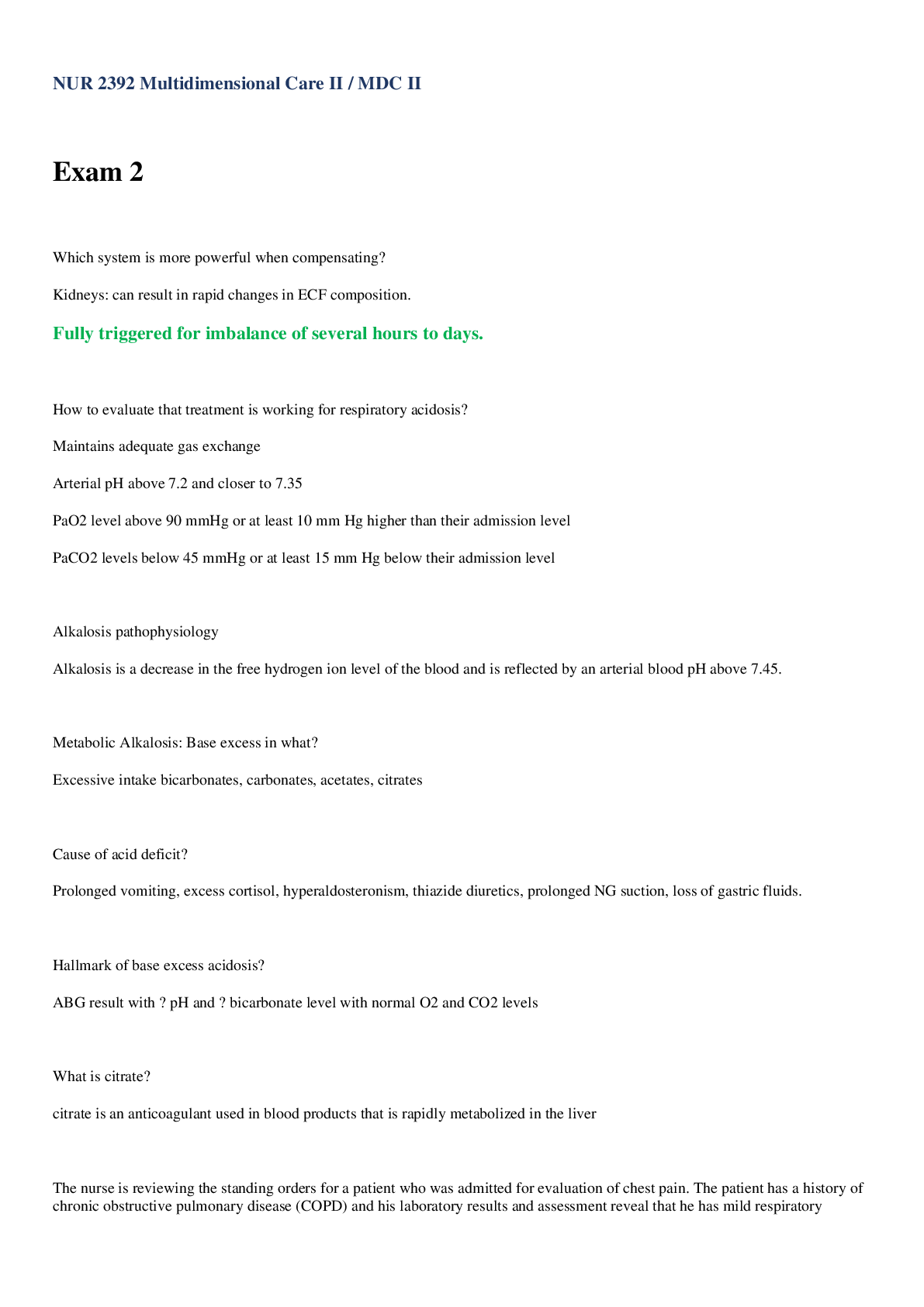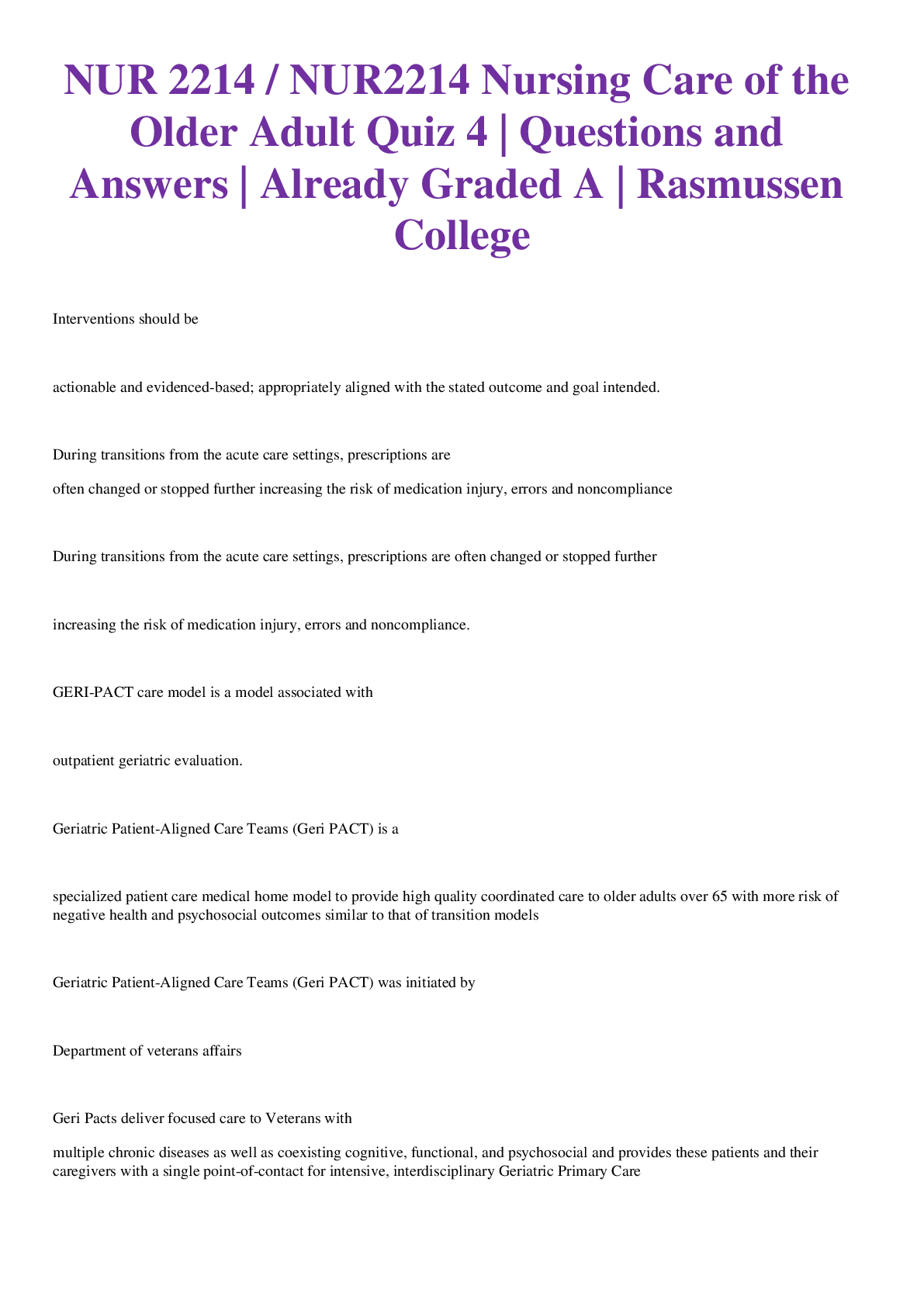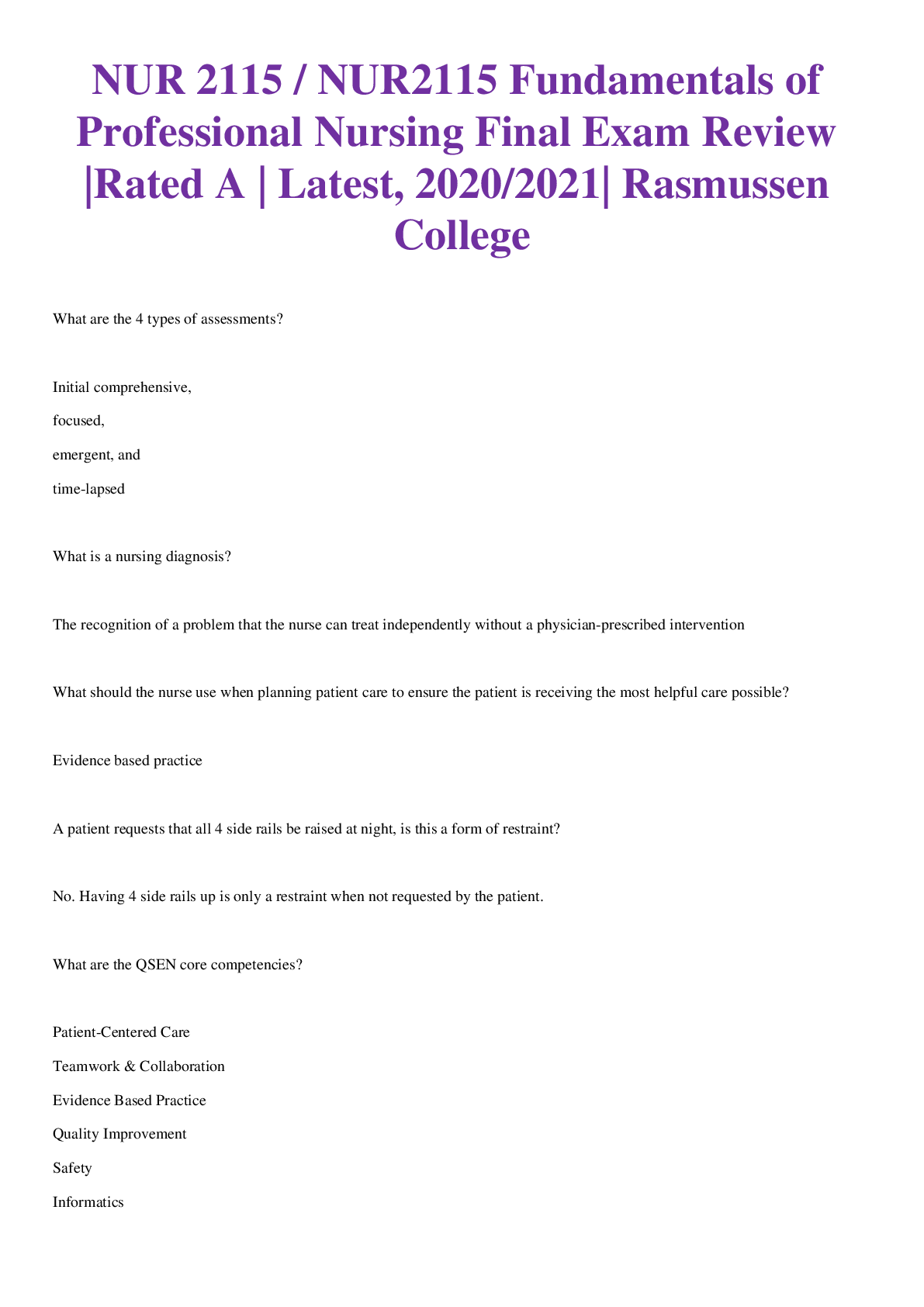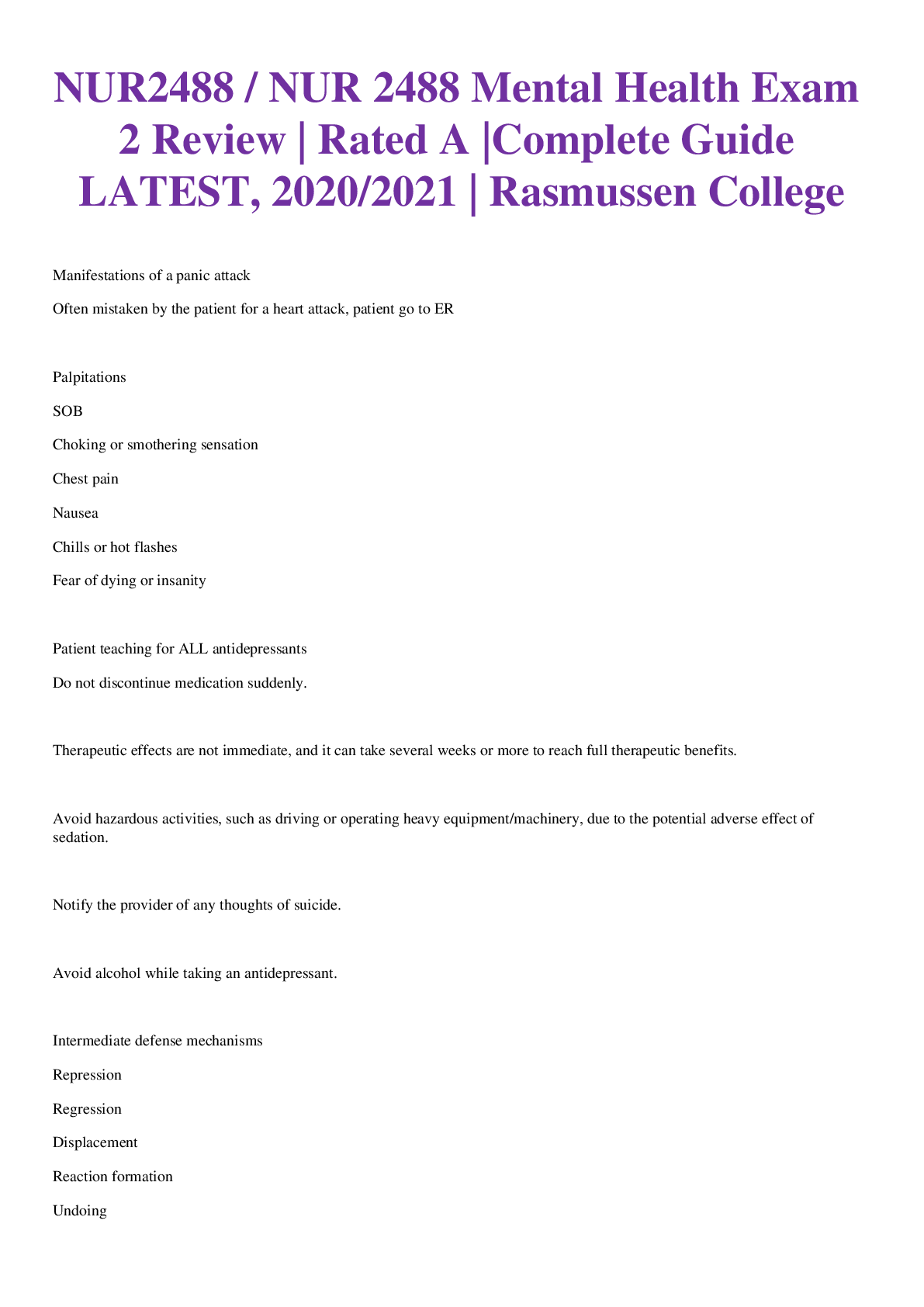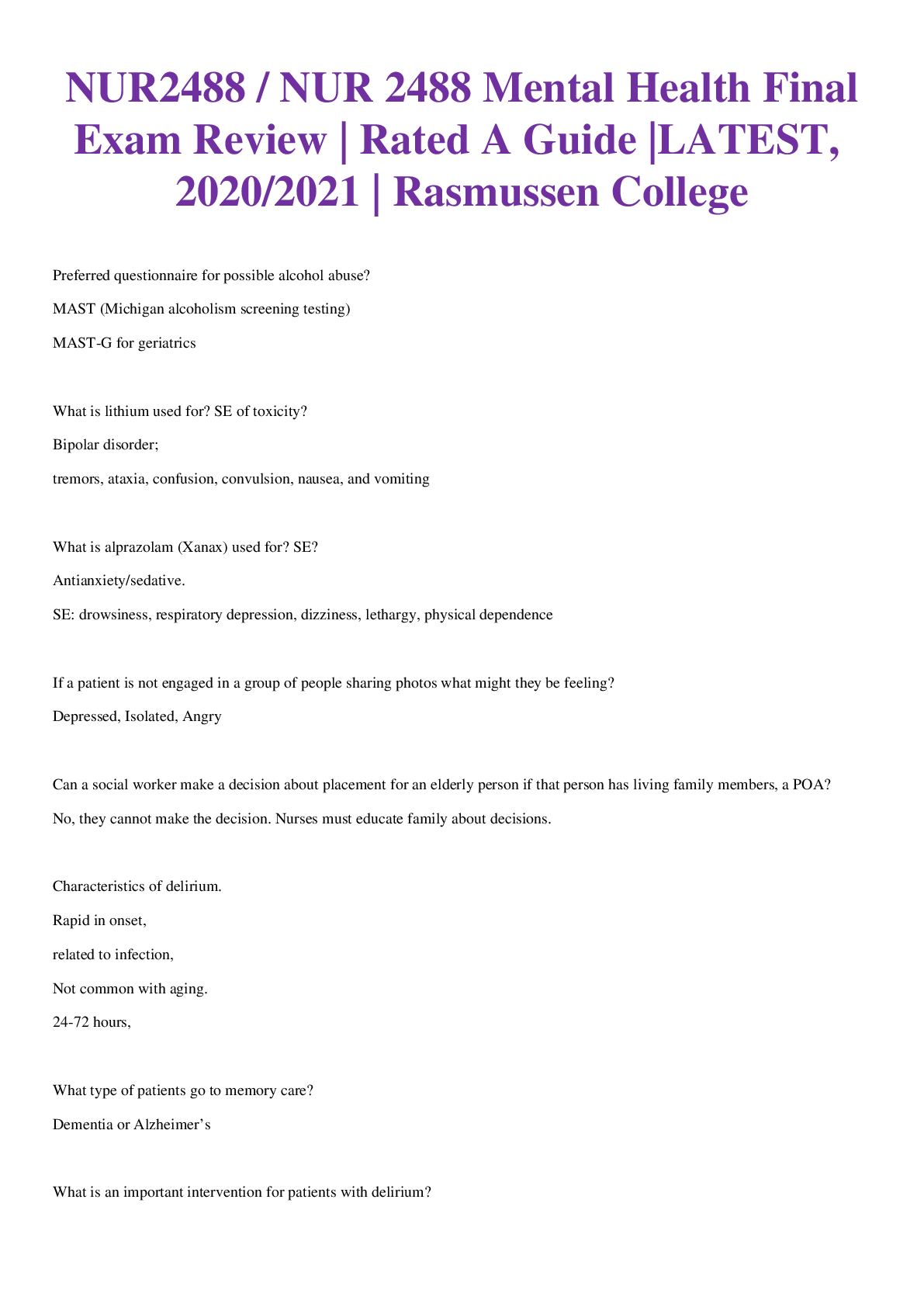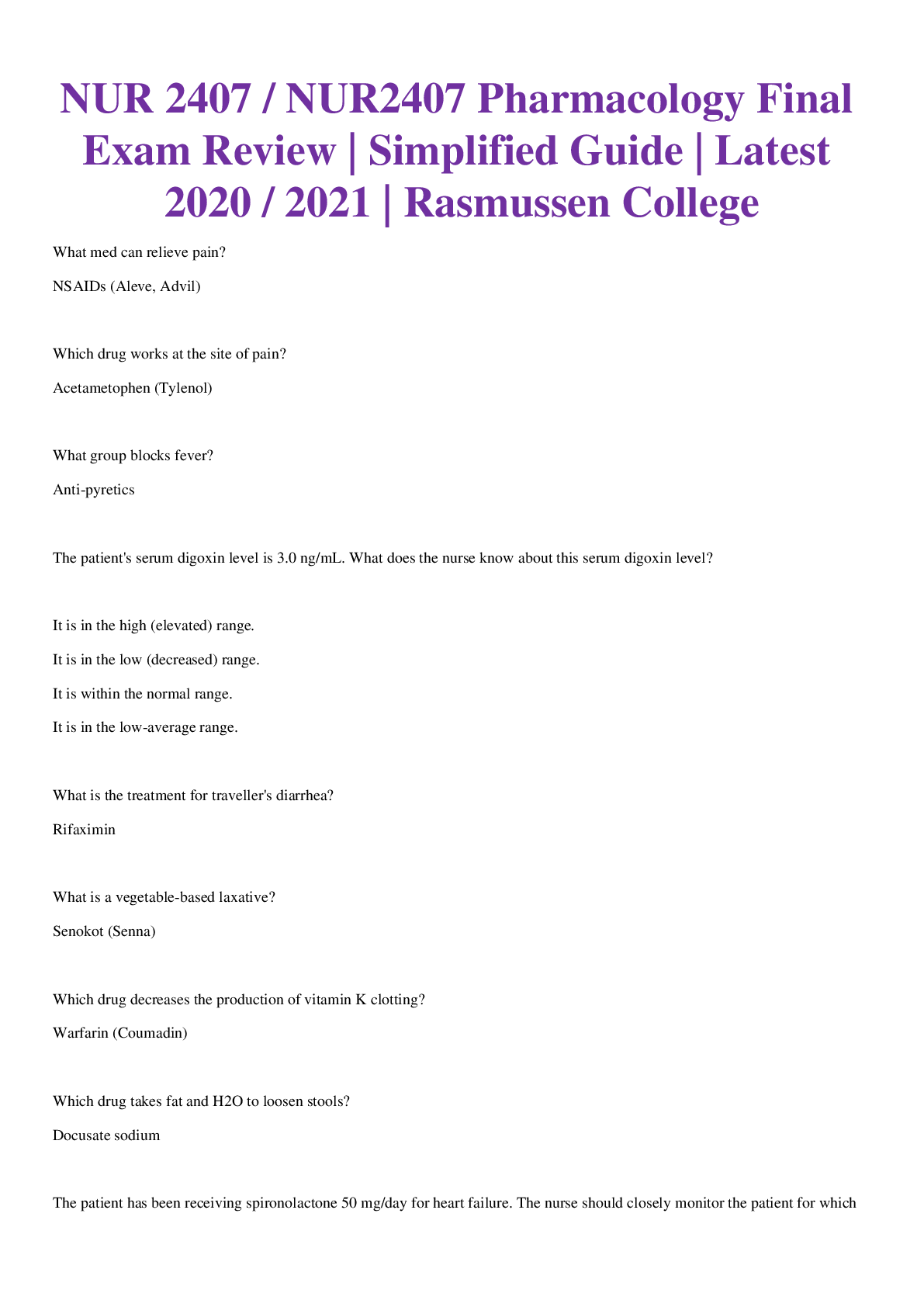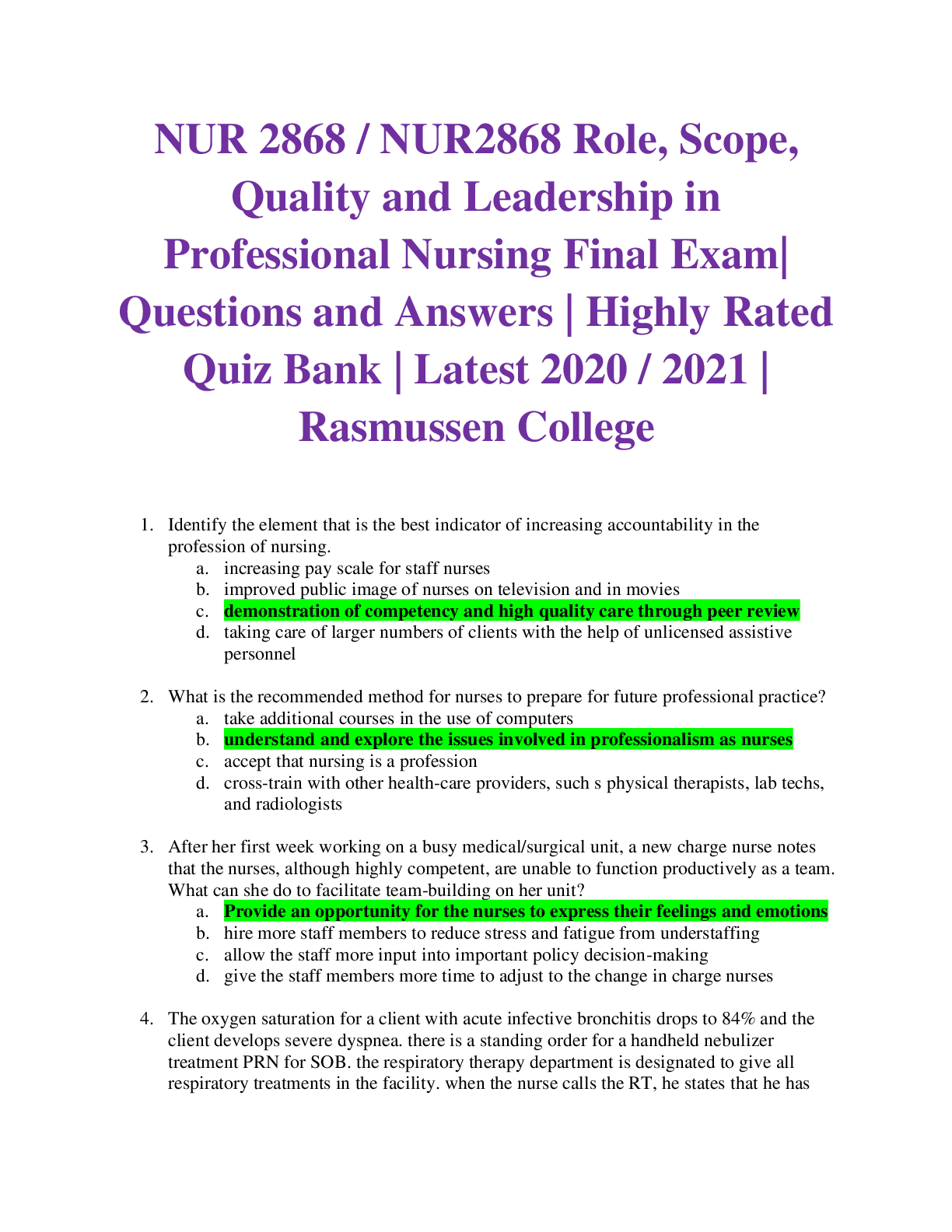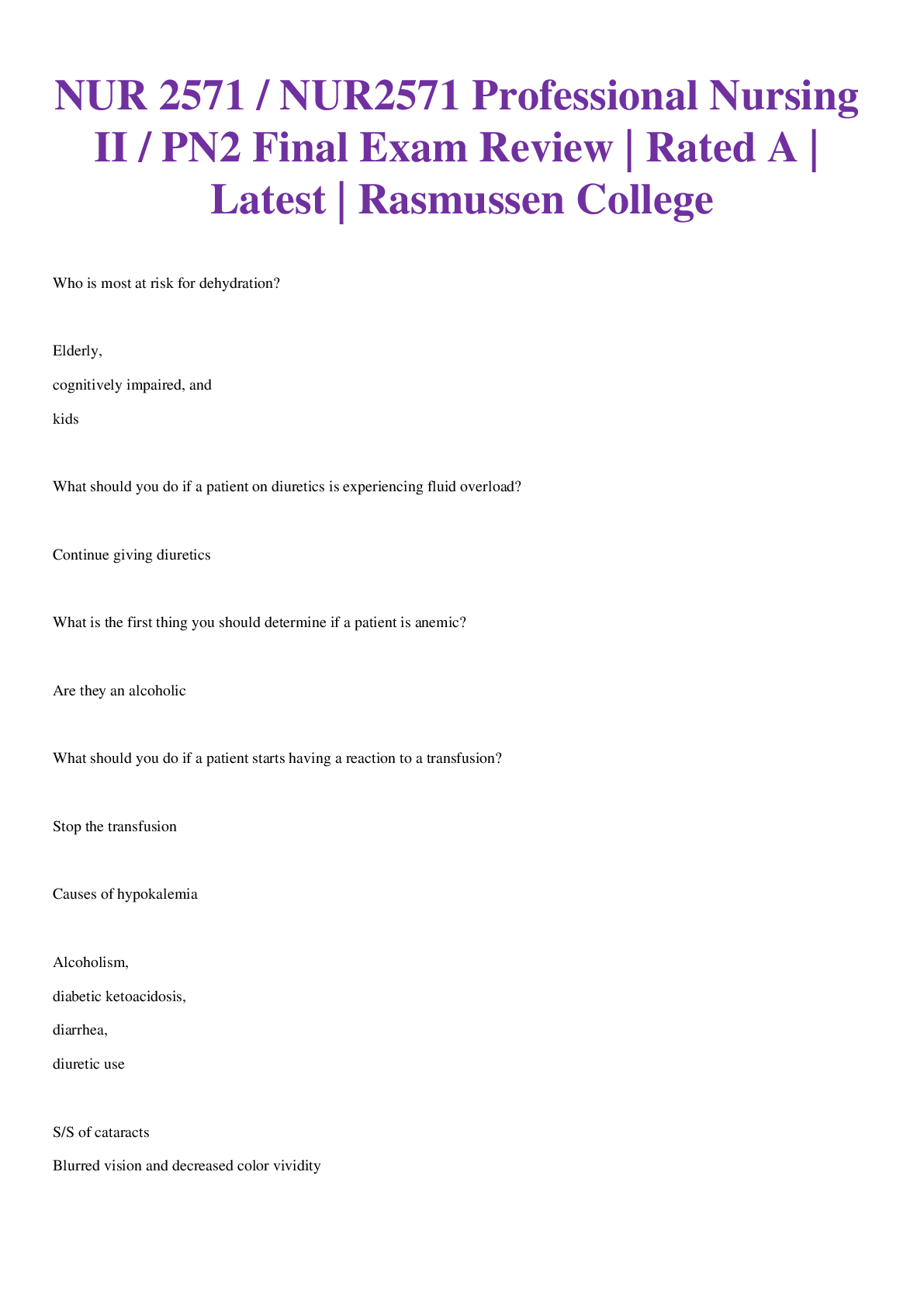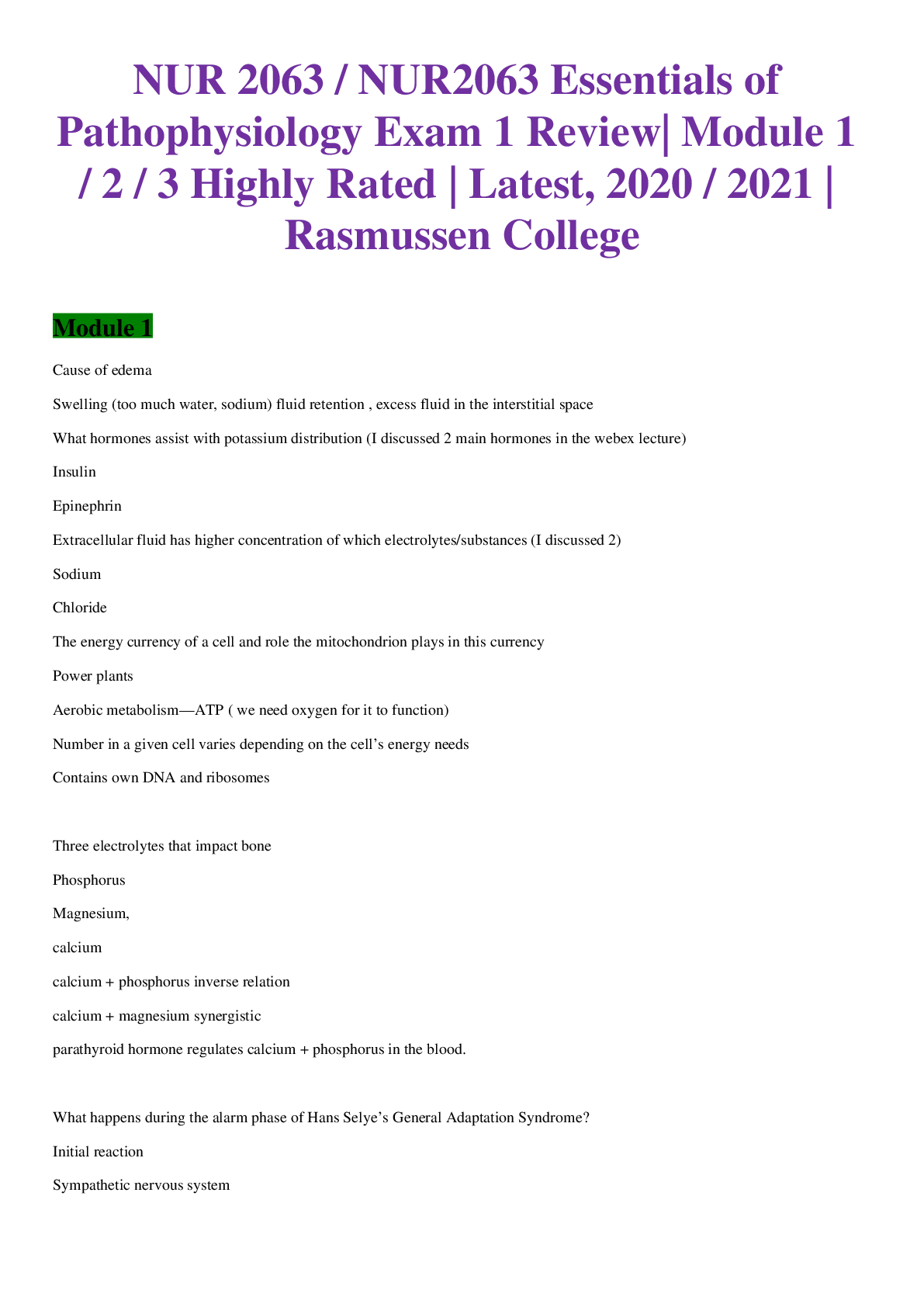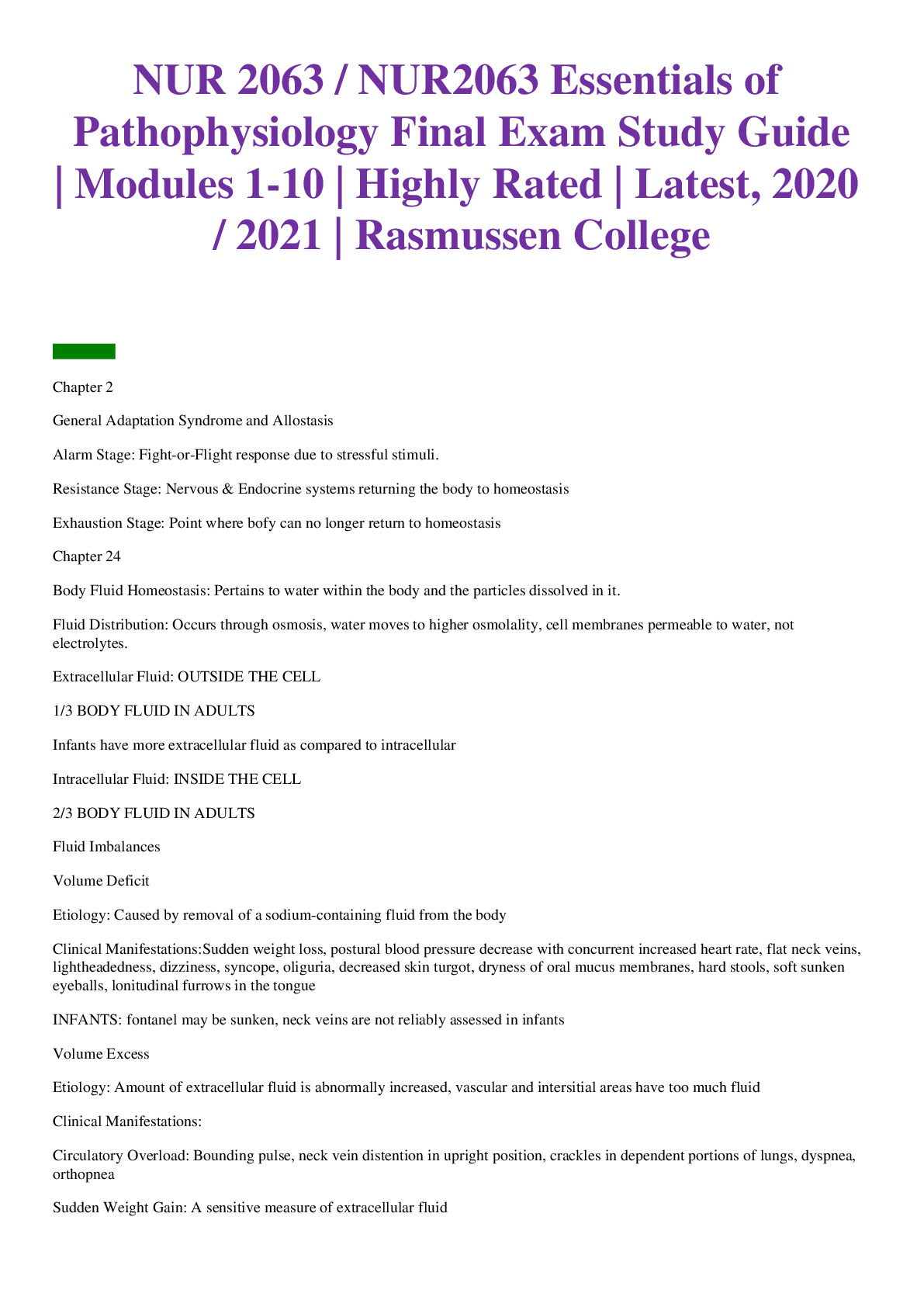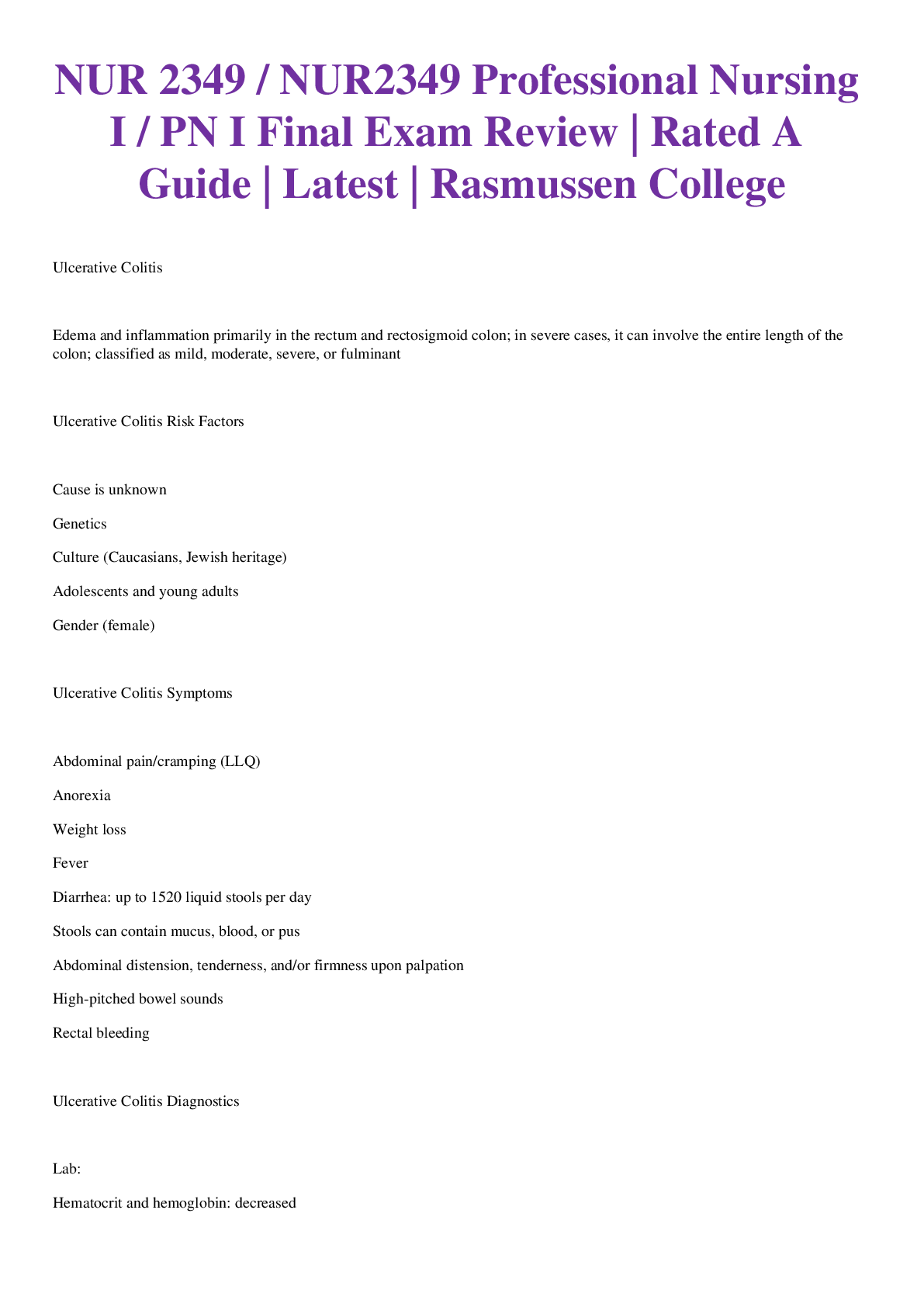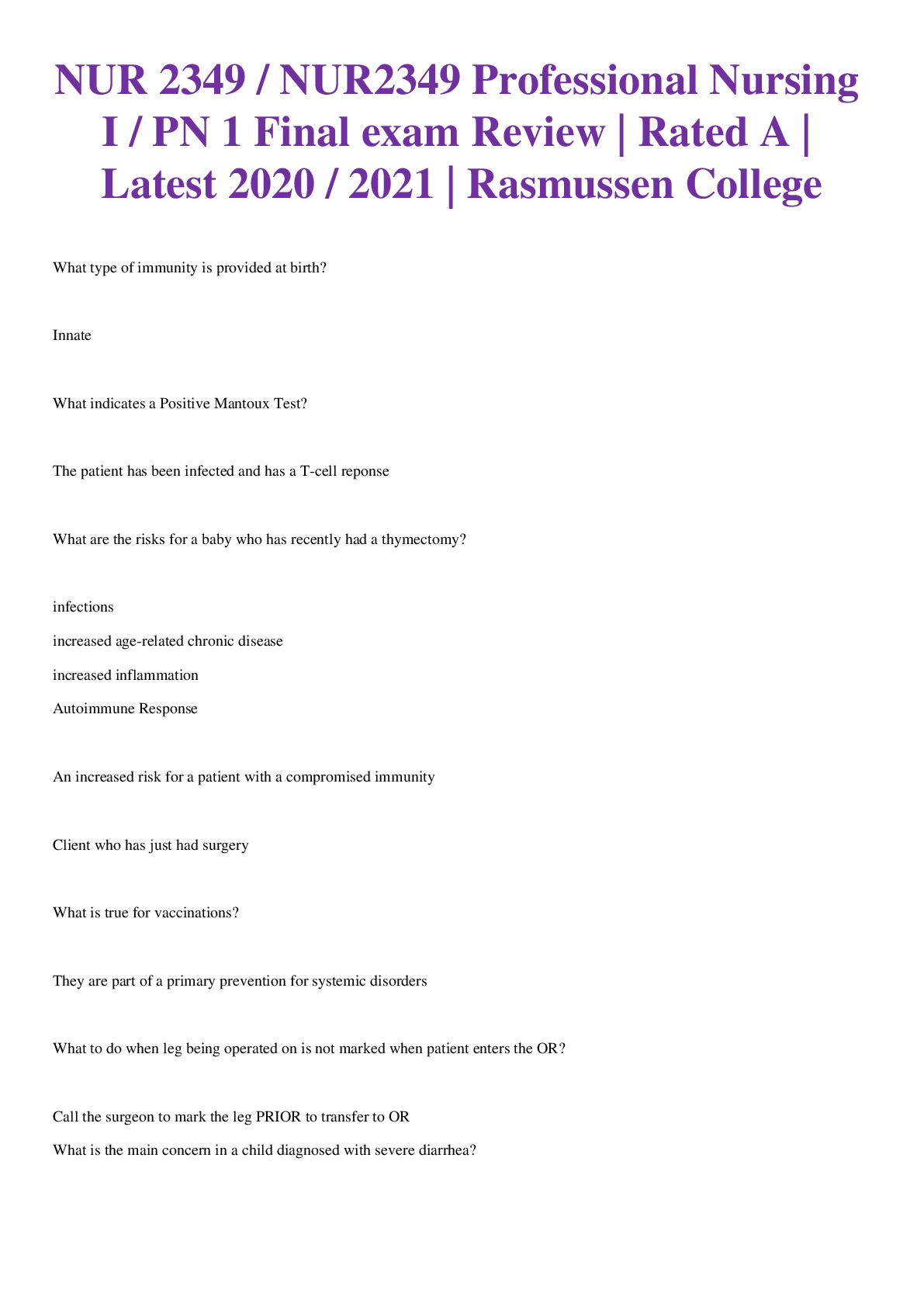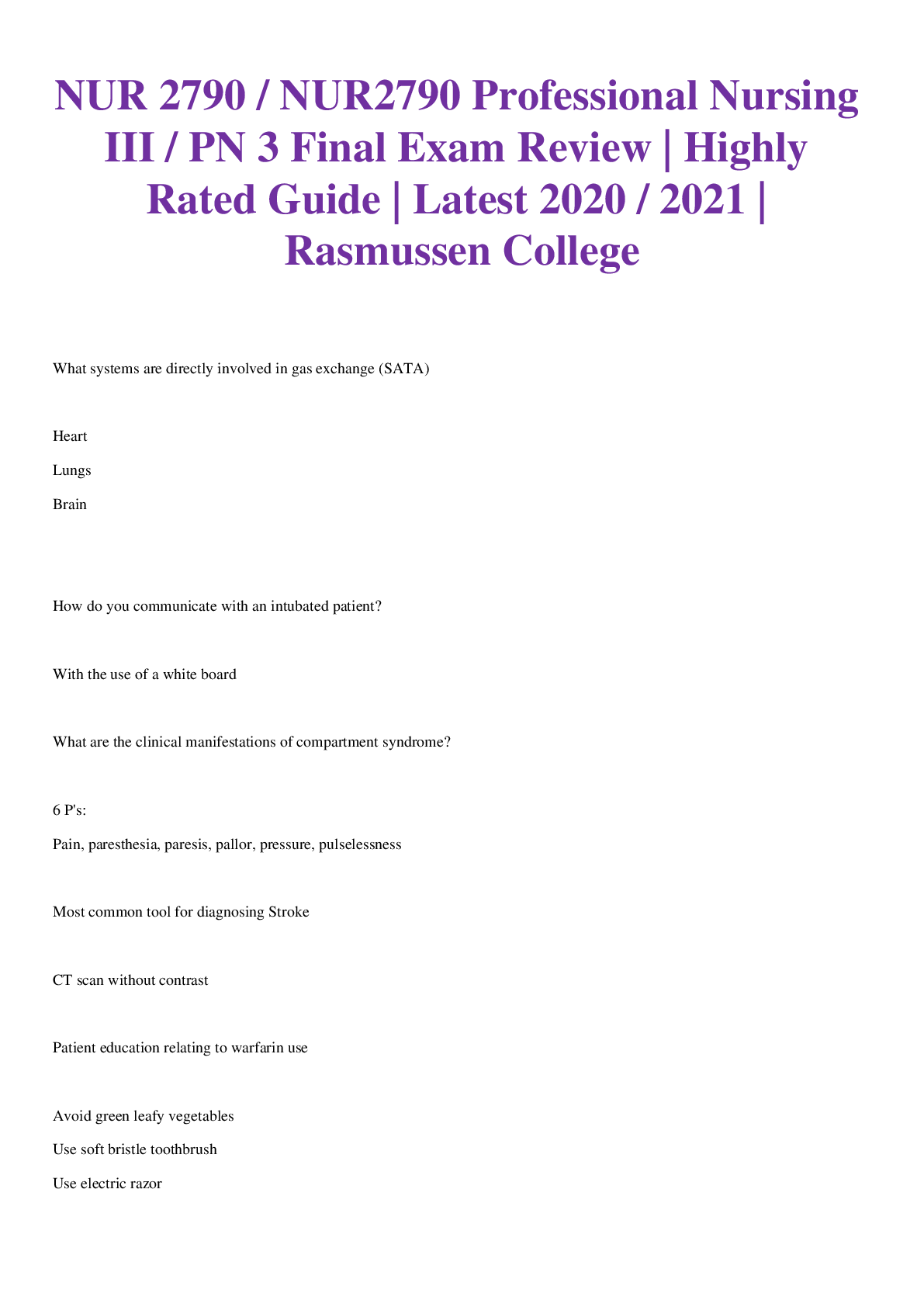*NURSING > EXAM > NUR 2392 / NUR2392 Multidimensional Care II Final Exam Quiz Bank / MDC II Final Exam Quiz Bank | Hig (All)
NUR 2392 / NUR2392 Multidimensional Care II Final Exam Quiz Bank / MDC II Final Exam Quiz Bank | Highly Rated | Latest 2021 / 2022 | Rasmussen College
Document Content and Description Below
NUR 2392 / NUR2392 Multidimensional Care II Final Exam Quiz Bank / MDC II Final Exam Quiz Bank | Highly Rated | Latest 2021 / 2022 | Rasmussen College Care of Patients with Oral Cavity Problems ... MULTIPLE CHOICE 1. A client is having a temporary tracheostomy placed during surgery for oral cancer. What action by the nurse is best to relieve anxiety? a. Agree on a postoperative communication method. b. Explain that staff will answer the call light promptly. c. Give the client a Magic Slate to write on postoperatively. d. Reassure the client that you will take care of all of his or her needs. RATIONALE: Before surgery that interrupts the clients ability to communicate, the nurse, client, and family (if possible) agree upon a method of communication in the postoperative period. The client may or may not prefer a slate and may not be able to communicate in writing. Reassuring the client and telling him or her you will take care of all of his or her needs does not help the client be an active participant in care. Ensuring that the staff will answer the call light promptly will not guarantee this will occur. 2. A nurse is caring for four clients. After receiving the hand-off report, which client should the nurse see first? a. Client having a radial neck dissection tomorrow who is asking questions b. Client who had a tracheostomy 4 hours ago and needs frequent suctioning c. Client who is 1 day postoperative for an oral tumor resection who is reporting pain d. Client waiting for discharge instructions after a small tumor resection RATIONALE: The client who needs frequent suctioning should be seen first to ensure that his or her airway is patent. The client waiting for pain medication should be seen next. The nurse may need to call the surgeon to see the client who is asking questions. The client waiting for discharge instructions can be seen last. 3. A client is prescribed cetuximab (Erbitux) for oral cancer and asks the nurse how it works. What response by the nurse is best? a. It blocks epidermal growth factor. b. It cuts off the tumors blood supply. c. It prevents tumor extension. d. It targets rapidly dividing cells. RATIONALE: Cetuximab (Erbitux) targets and blocks the epidermal growth factor, which contributes to the growth of oral cancers. The other explanations are not correct. 4. A client had an oral tumor removed this morning and now has a tracheostomy. What action by the nurse is the priority? a. Delegate oral care every 4 hours. b. Monitor and record the clients intake. c. Place the client in a high-Fowlers position. d. Remove the inner cannula for cleaning. RATIONALE: To promote airway clearance, this client should be placed in a semi- or high-Fowlers position. Oral care can be delegated, but that is not the priority. Intake and output should also be recorded but again is not the priority. The inner cannula may or may not need to be cleaned, and the tracheostomy may or may not have a disposable cannula. 5. A nurse assesses a clients oral cavity and observes the condition depicted in the photo below: What action by the nurse is best? a. Ask about the clients human immunodeficiency virus (HIV) status. b. Assess the client for dysphagia. c. Listen to the clients lung sounds. d. Refer the client to an oncologist. RATIONALE: This client has oral candidiasis. If the infection extends down the pharynx, the client could have difficulty swallowing. Therefore, the nurse should assess the client for dysphagia. HIV status may or may not be related but is not the priority. Listening to the lungs is unrelated. Since oral candidiasis is an infectious condition, referral to an oncologist is not needed. 6. A student nurse is providing care to an older client with stomatitis and dysphagia. What action by the studen nurse requires the registered nurse to intervene? a. Assisting the client to perform oral care every 2 hours b. Preparing to administer a viscous lidocaine gargle c. Reminding the client not to swallow nystatin (Mycostatin) d. Teaching the client to use a soft-bristled toothbrush RATIONALE: Viscous lidocaine gargles or mouthwashes are sometimes prescribed for clients with stomatitis and pain. However, the numbing effect can lead to choking or mouth burns from hot food. This client already has difficulty swallowing, so this medication is not appropriate. Therefore, the nurse should intervene when the student prepares to administer this preparation. The other options are correct actions. 7. A client has a large oral tumor. What assessment by the nurse takes priority? a. Airway b. Breathing c. Circulation d. Nutrition RATIONALE: Airway always takes priority. Airway must be assessed first and any problems resolved if present. 8. A female client hospitalized for an unrelated problem has a large pearly-white lesion on her lip, to which she continues to apply lipstick that she will not remove for inspection. The client refuses to discuss the lesion with the nurse or health care provider. What action by the nurse is best? a. Ask the client why her appearance is so important. b. Ignore the lesion since the client will not discuss it. c. Inform the client that early-stage cancer is curable. d. Work with the client to establish a trusting relationship. RATIONALE: Clients with oral cancers often have body image difficulties due to the location of the tumor or the results of surgical treatment. This client appears to be using denial to cope with this problem. The nurse should work to establish a helping-trusting relationship in hopes that the client will be amenable to future discussions about the lesion. Asking why questions often puts people on the defensive and should be avoided. Ignoring the lesion is not being an advocate for the client. Education is important, but right now the client is in denial, so this information will not seem relevant to her. 9. A nurse has conducted a community screening event for oral cancer. What client is the highest priority for referral to a dentist? a. Client who has poor oral hygiene practices b. Client who smokes and drinks daily c. Client who tans for an upcoming vacation d. Client who occasionally uses illicit drugs RATIONALE: Smoking and alcohol exposure create a high risk for this client. Poor oral hygiene is not related to the etiology of cancer but may cause a tumor to go unnoticed. Tanning is a risk factor, but short-term exposure does not have the same risk as daily exposure to tobacco and alcohol. Illicit drugs are not related to oral cancers. 10. The nurse reads a clients chart and sees that the health care provider assessed mucosal erythroplasia. What should the nurse understand that this means for the client? a. Early sign of oral cancer b. Fungal mouth infection c. Inflammation of the gums d. Obvious oral tumor RATIONALE: Mucosal erythroplasia is the earliest sign of oral cancer. It is not a fungal infection, inflammation of the gums, or an obvious tumor. MULTIPLE RESPONSE 1. The nurse is caring for a client with sialadenitis. What comfort measures may the nurse delegate to the unlicensed assistive personnel (UAP)? (Select all that apply.) a. Applying warm compresses b. Massaging salivary glands c. Offering fluids every hour d. Providing lemon-glycerin swabs e. Reminding the client to avoid speaking RATIONALE: The UAP can apply warm compresses and offer fluids. Massaging salivary glands can be done, but not by the UAP. Lemon-glycerin swabs are drying and should not be used. Speaking has no effect on this condition. 2. A nurse studying cancer knows that job-related risks for developing oral cancer include which occupations? (Select all that apply.) a. Coal miner b. Electrician c. Metal worker d. Plumber e. Textile worker RATIONALE: The occupations of coal mining, metal working, plumbing, and textile work produce exposure to polycyclic aromatic hydrocarbons (PAHs), which are known carcinogens. Electricians do not have this risk. Care of Patients with Esophageal Problems MULTIPLE CHOICE 1. A client is 1 day postoperative after having Zenkers diverticula removed. The client has a nasogastric (NG) tube to suction, and for the last 4 hours there has been no drainage. There are no specific care orders for the NG tube in place. What action by the nurse is most appropriate? [Show More]
Last updated: 1 month ago
Preview 1 out of 72 pages
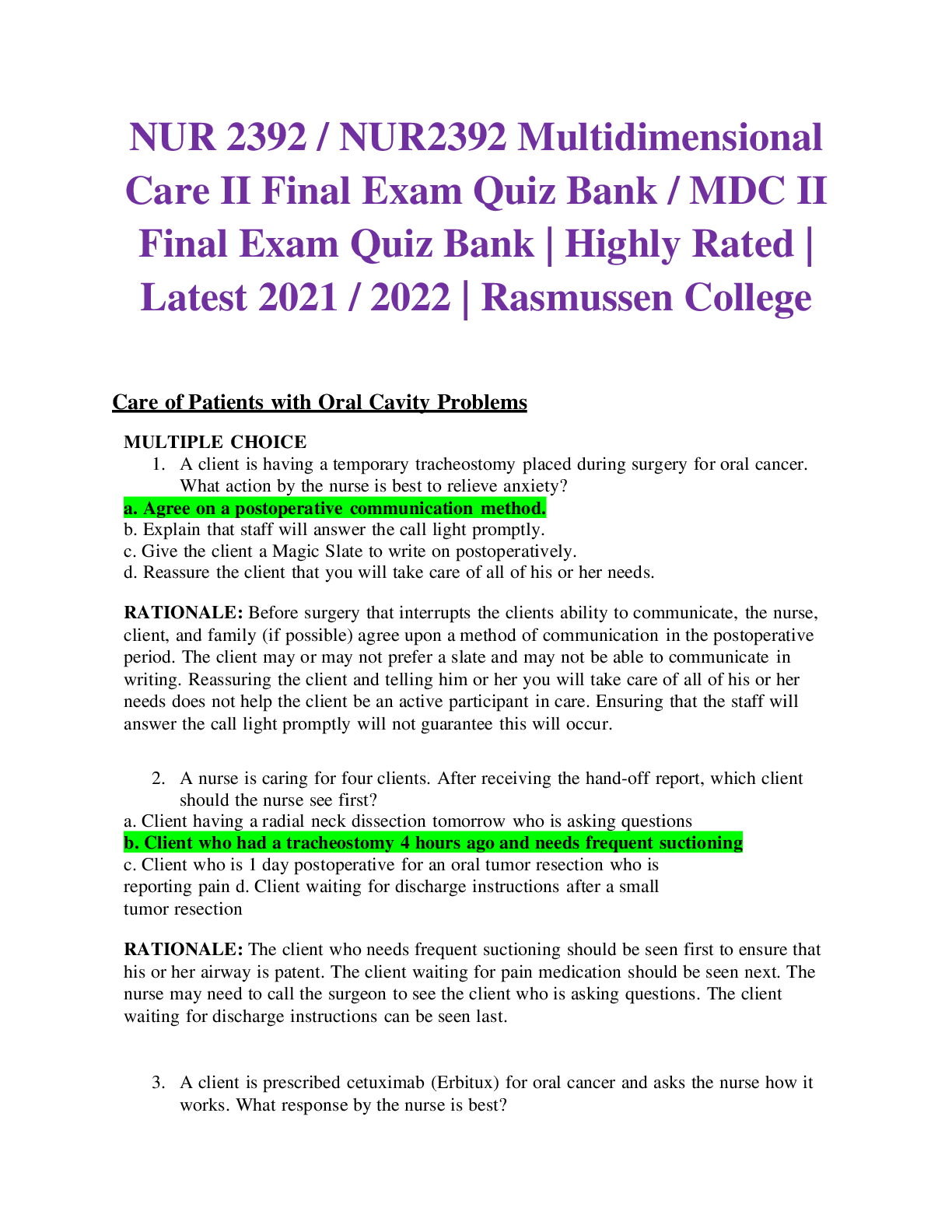
Reviews( 0 )
Document information
Connected school, study & course
About the document
Uploaded On
Mar 16, 2021
Number of pages
72
Written in
Additional information
This document has been written for:
Uploaded
Mar 16, 2021
Downloads
0
Views
64

